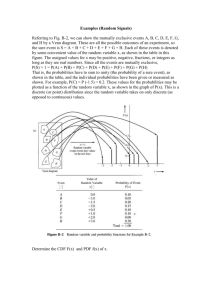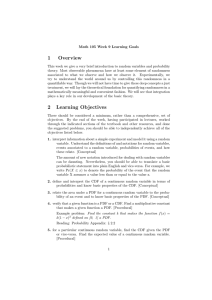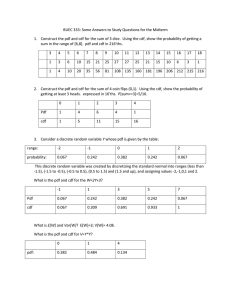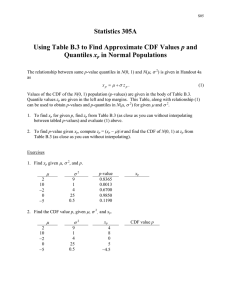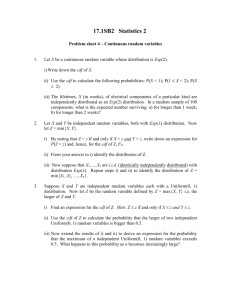Lesson 2. Probability Review 1 Random variables
advertisement
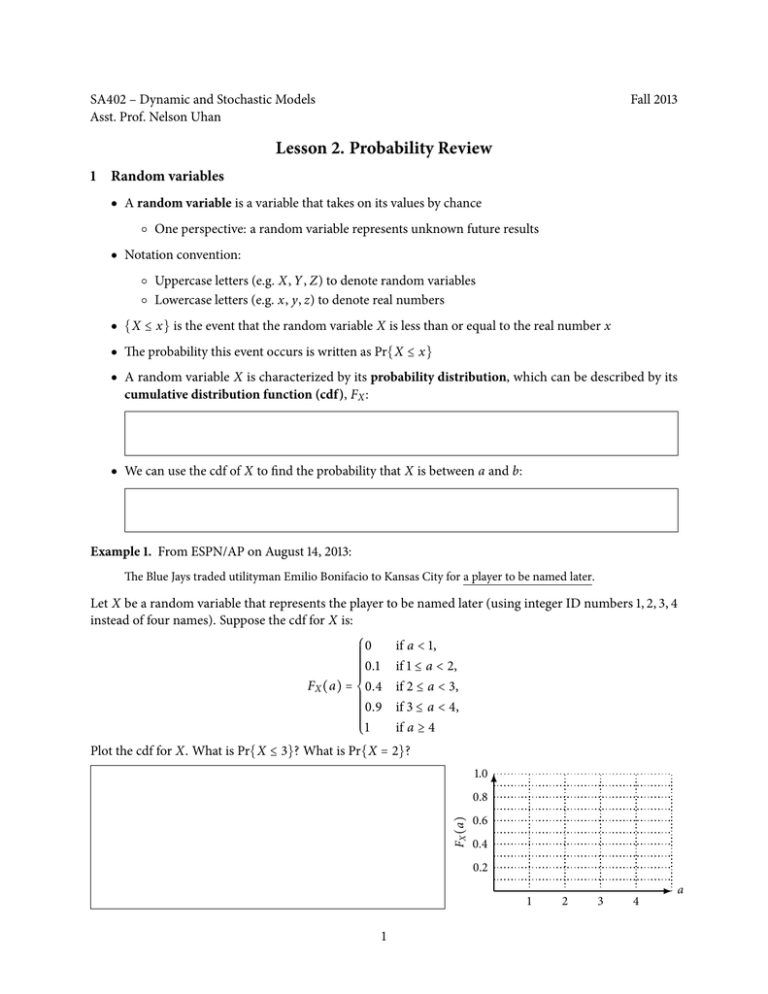
SA402 – Dynamic and Stochastic Models
Asst. Prof. Nelson Uhan
Fall 2013
Lesson 2. Probability Review
1
Random variables
● A random variable is a variable that takes on its values by chance
○ One perspective: a random variable represents unknown future results
● Notation convention:
○ Uppercase letters (e.g. X, Y , Z) to denote random variables
○ Lowercase letters (e.g. x, y, z) to denote real numbers
● {X ≤ x} is the event that the random variable X is less than or equal to the real number x
● The probability this event occurs is written as Pr{X ≤ x}
● A random variable X is characterized by its probability distribution, which can be described by its
cumulative distribution function (cdf), FX :
● We can use the cdf of X to find the probability that X is between a and b:
Example 1. From ESPN/AP on August 14, 2013:
The Blue Jays traded utilityman Emilio Bonifacio to Kansas City for a player to be named later.
Let X be a random variable that represents the player to be named later (using integer ID numbers 1, 2, 3, 4
instead of four names). Suppose the cdf for X is:
⎧
0
if a < 1,
⎪
⎪
⎪
⎪
⎪
⎪
0.1 if 1 ≤ a < 2,
⎪
⎪
⎪
⎪
FX (a) = ⎨0.4 if 2 ≤ a < 3,
⎪
⎪
⎪
⎪
0.9 if 3 ≤ a < 4,
⎪
⎪
⎪
⎪
⎪
⎪
if a ≥ 4
⎩1
Plot the cdf for X. What is Pr{X ≤ 3}? What is Pr{X = 2}?
1.0
F X (a)
0.8
0.6
0.4
0.2
1
1
2
3
4
a
● Some properties of generic cdf F(a):
○ Domain:
○ Range:
○ As a increases, F(a)
◇ In other words, F is
○ F is right-continuous: if F has a discontinuity at a, then F(a) is determined by the piece of the
function on the right-hand side of the discontinuity
● A random variable is discrete if it can take on only a finite or countably infinite number of values
○ Let X be a discrete random variable that takes on values a1 , a2 , . . .
○ The probability mass function (pmf) p X of X is:
○ The pmf and cdf of a discrete random variable are related:
● A random variable is continuous if it can take on a continuum of values
○ The probability density function (pdf) f X of a continuous random variable X is:
○ We can get the cdf from the pdf:
Example 2. Find the pmf of X defined in Example 1.
2
Example 3. Let Y be a exponentially distributed random variable with parameter λ. In other words, the cdf
of Y is
⎧
⎪
if a < 0,
⎪0
FY (a) = ⎨
−λa
⎪
if a ≥ 0.
⎪
⎩1 − e
Find the pdf of Y.
Let λ = 2. Plot the pdf of Y.
For this random variable, which values are more likely or less likely?
What is Pr{Y = 3}?
f Y (a)
a.
b.
c.
d.
a
2
Expected value
● The expected value of a random variable is its weighted average
● If X is a discrete random variable taking values a1 , a2 , . . . with pmf p X , then the expected value of X is
● If X is a continuous random variable with pdf f X , then the expected value of X is
● We can similarly take the expected value of a function g of a random variable X
○ X is discrete:
○ X is continuous:
● The variance of X is
3
Example 4. Find the expected value and the variance of X, as defined in Example 1.
Example 5. The indicator function I(⋅) takes on the value 1 if its argument is true, and 0 otherwise. Let X be
a discrete random variable that takes on values a1 , a2 , . . . . Find E[I(X ≤ b)].
● Example 5 works similarly for continuous random variables
● Probabilities can be expressed as the expected value of an indicator function
● Some useful properties: let X, Y be random variables, and a, b be constants
○ E[aX + b] = aE[X] + b
○ E[X + Y] = E[X] + E[Y]
○ Var(a + bX) = b2 Var(X)
○ In general, E[g(X)] ≠ g(E[X])
3
Joint distributions and independence
● Let X and Y be random variables
● X and Y could be dependent
○ For example, X and Y are the times that the 1st and 2nd customers wait in the queue, respectively
● If we want to determine the probability of an event that depends both on X and Y, we need their joint
distribution
● The joint cdf of X and Y is:
4
● Two random variables X and Y are independent if knowing the value of X does not change the
probability distribution for the value of Y
● Mathematically speaking, X and Y are independent if
● Independence makes dealing with joint distributions easier!
● Idea generalizes to 3 or more variables
4
Exercises
Problem 1 (Nelson 3.1). Calculate the following probabilities from the cdf given in Example 1. In each case,
begin by writing the appropriate probability statement, for example Pr{X = 4}; then calculate the probability.
a.
b.
c.
d.
The probability that player 4 will be traded.
The probability that player 2 will not be traded.
The probability that the index of the player traded will be less than 3.
The probability that the index of the player traded will be larger than 1.
Problem 2 (Nelson 3.2). Let Y be an exponential random variable with parameter λ = 2 that models the time
to deliver a pizza in hours. Calculate the following probabilities. In each case, begin by writing the appropriate
probability statement, for example Pr{Y ≤ 1/2}; then calculate the probability.
a. The pizza-delivery company promises delivery within 40 minutes or the pizza is free. What is the
probability that it will have to give a pizza away for free?
b. The probability that delivery takes longer than 1 hour.
c. The probability that delivery takes between 10 and 40 minutes.
d. The probability that delivery takes less than 5 minutes.
Problem 3 (Nelson 3.3). A random variable X has the following cdf:
⎧
0
⎪
⎪
⎪
⎪ a2
FX (a) = ⎨ δ 2
⎪
⎪
⎪
⎪
⎩1
if a < 0,
if 0 ≤ a ≤ δ,
if a > δ
a. What is the density function of X?
b. What is the maximum possible value that X can take?
c. What is the expected value of X?
Problem 4 (Nelson 3.5). A random variable Y has the following pdf:
⎧
0
⎪
⎪
⎪
⎪3 2
fY (a) = ⎨ 16 a +
⎪
⎪
⎪
⎪
⎩0
1
4
if a < 0,
if 0 ≤ a ≤ 2,
if a > 2
a. What is the expected value of Y?
b. What is the cdf of Y?
c. For this random variable, which is more likely: a value near 1/2 or a value near 3/2?
5


